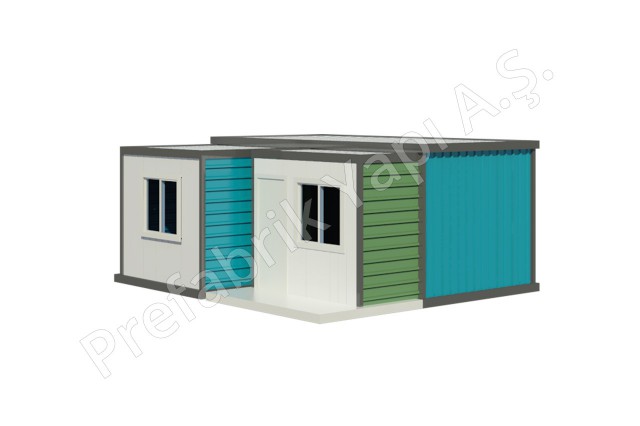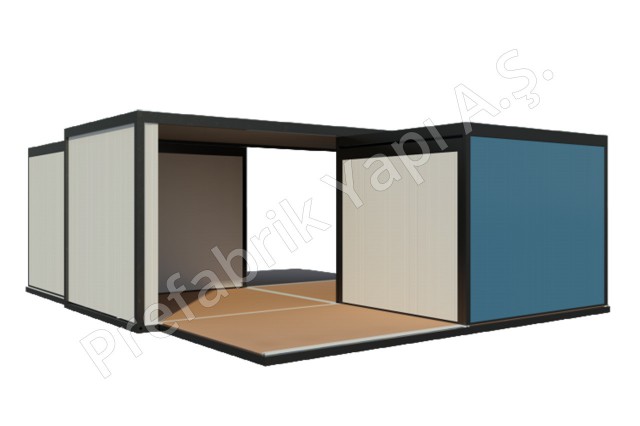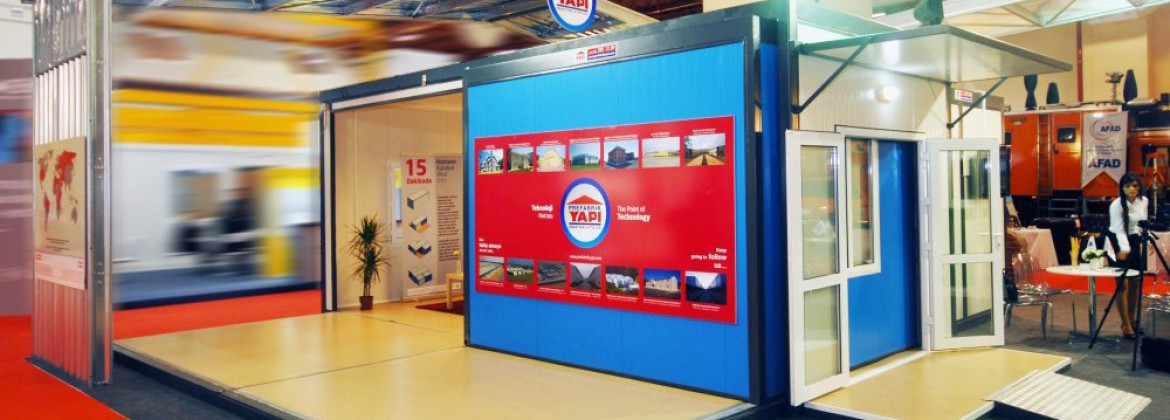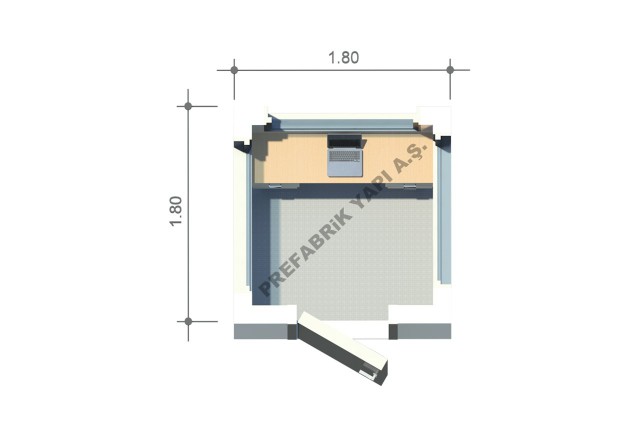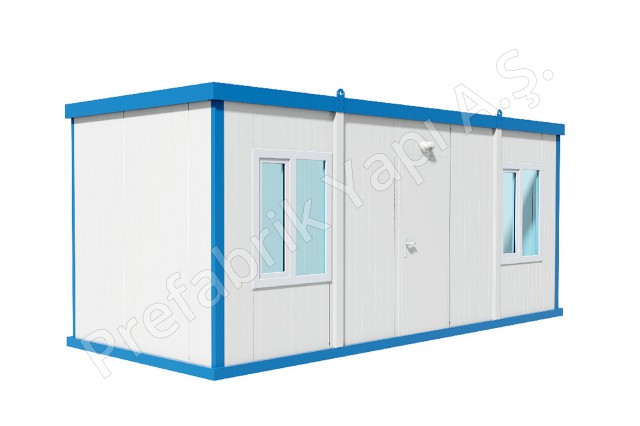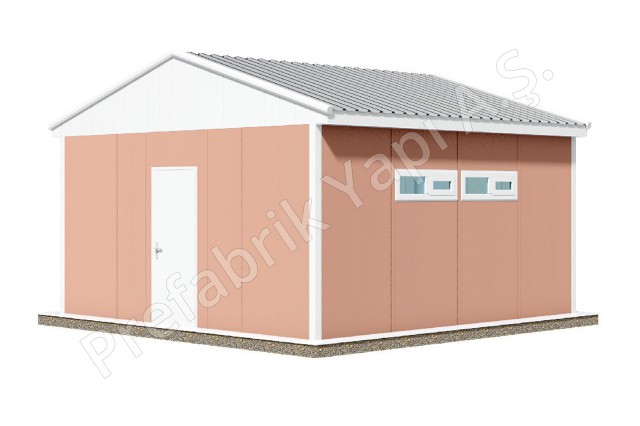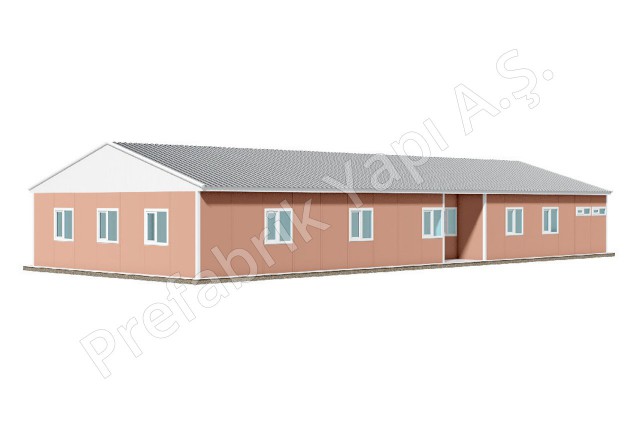Nested Container
Product Category: Nested Container
Nested Container - Standard Plans
Collapsible container is carried as 3.00×7.00 m during transportation. After settling on the place with crane, the folded frames on the sides are opened and the modules inside are slided onto these frames with manpower. It is ready for use as a 56 m2 3+1 building as seen in the drawing after this simple procedure. Collapsible container’s main module is prepared as 3.00×7.00 m h:3.00 m and can be designed in 4 rooms, 3 rooms, 2 rooms subject to the design of the modules inside.
Collapsible containers are foldable structures that offer maximum efficiency in transportation and storage. These containers are made from durable materials. They can be folded when not in use to save space. They provide practical solutions in various fields such as storage, logistics, construction, and temporary housing. Their quick installation and portability make them a good choice.
What Is Collapsible Containers?
Collapsible containers are innovative, foldable structures designed to provide flexible and portable storage or housing solutions. These containers are made from durable materials and are engineered to be easily folded when not in use, optimizing transportation and space efficiency. They are increasingly being used across multiple industries due to their practicality and cost-effectiveness.
These containers can range from simple collapsible storage containers used for organizing goods to fully functional collapsible container homes that serve as living spaces. The concept of containers collapsible in nature allows for quick installation and takedown, making them ideal for dynamic environments where temporary yet stable structures are required. Their versatility and convenience make them an important innovation in modern container design.
Features Of Collapsible Containers
Collapsible containers come with a range of features that distinguish them from traditional storage or housing options. One of their primary attributes is their foldable design, which allows them to be compacted into a flat structure for easy transport or storage. This makes collapsible shipping containers especially popular in logistics and international trade, where space and efficiency are critical.
Another important feature is their durability. Built using high-quality materials such as steel, aluminum, or reinforced polymers, these containers can withstand harsh environmental conditions. Whether used as collapsible container house units or collapsible storage containers, they offer long-lasting functionality. Additionally, they often include secure locking systems, ventilation panels, and insulation options, ensuring comfort and safety for both people and goods.
Collapsible Containers Models And Plans
The market offers a wide variety of collapsible containers tailored to different needs. From compact storage units to fully equipped collapsible container homes, there are models designed for residential, commercial, and industrial use. Standardized modular designs make customization easier and allow multiple units to be connected, creating larger living or working spaces.
These plans typically focus on user-friendly assembly and transportability. Popular models include collapsible shipping containers that fold down to a fraction of their size, saving space during return shipping. In contrast, collapsible container housing plans come with insulation, plumbing, and electrical options, allowing for modern living standards in mobile formats. Whether for storage or shelter, there is a solution available to fit diverse applications.
Collapsible Container Dimensions
The size and scale of collapsible containers can differ depending on their design and intended function. Typically, collapsible shipping containers are produced in widely accepted global standards that ensure they can be easily transported and handled across various logistics systems. These dimensions are structured to align with the equipment used in shipping, trucking, and freight handling.
On the other hand, collapsible storage containers are often designed in more compact forms to support easy stacking and storage. Their flexible size options make them suitable for different operational needs, whether for personal, industrial, or commercial purposes. Additionally, some collapsible container designs are modular, allowing for custom combinations to create larger or more complicated installations.
Advantages Of Collapsible Containers
One of the key benefits of collapsible containers is their space-saving nature. When not in use, these containers can be folded down, significantly reducing their volume and making them easy to transport or store. This is particularly valuable in industries that rely on logistics efficiency, such as shipping and construction. In this context, collapsible shipping containers are a preferred choice due to their foldability and reusability.
Additionally, these containers offer flexibility in design and use. Whether you’re setting up a temporary office, storage unit, or a collapsible container house, these structures adapt to a variety of environments. They also contribute to reduced transportation costs and lower carbon footprints by minimizing empty return trips. In regions where mobility and rapid deployment are essential, containers collapsible in design stand out as both a practical and sustainable solution.
How Much Do Collapsible Containers Cost?
The cost of collapsible containers can vary widely depending on their size, features, and intended use. Basic collapsible storage containers might be relatively inexpensive, especially when purchased in bulk. However, more complex options like collapsible container homes with added amenities such as insulation, plumbing, and electrical systems can be more costly due to customization and added materials.
In general, collapsible shipping container prices depend on dimensions (20ft, 40ft, etc.), materials used, and optional features. The foldable design itself may add to the cost compared to traditional fixed containers, but the long-term savings on transportation and storage often make up for the initial investment. Whether you are purchasing for commercial, industrial, or residential purposes, understanding the specific requirements of your collapsible container project will help you determine the most cost-effective model.
Collapsible Containers Areas Of Use
Collapsible containers are utilized in many sectors thanks to their portable structure and quick installation features. These containers are highly practical for areas where temporary or mobile solutions are needed. From construction to humanitarian aid, their applications are widespread. For instance, collapsible container homes offer fast shelter solutions, while collapsible storage containers help with efficient material management in industrial zones.
Whether used as collapsible container house units in remote areas or as collapsible shipping containers for international cargo transport, their modular and foldable nature gives them a significant advantage. The following use cases highlight just how versatile containers collapsible can be in real-world applications.
Construction Sites And Construction Areas
On construction sites, collapsible containers serve multiple purposes. They can be used as mobile offices, tool storage units, or temporary staff accommodations. Their capability of quick installation and disassemble make them ideal for the ever-changing nature of construction environments.
Emergency And Disaster Housing
Collapsible container homes can be rapidly deployed to provide immediate shelter in emergency situations such as natural disasters or displacement crises. Their ability to be transported and assembled quickly makes them an essential solution for humanitarian efforts.
Military And Mobile Bases
Collapsible shipping containers are frequently used in military and remote operations. They can be customized into command centers, medical stations, or storage units, providing versatile solutions for mobile bases and field missions.
Collapsible Container Assembly And Installation Process
The assembly process for collapsible containers is designed to be fast and user-friendly. Most models arrive in a folded, compact form and can be unfolded on-site using basic equipment and minimal labor. This is one of the primary reasons why collapsible shipping containers and collapsible container homes are preferred in time-sensitive situations such as emergency deployments or temporary construction setups.
Once the collapsible container is unfolded, structural components such as walls, floors, and roofing are locked into place. Depending on the model, additional installations like electrical wiring, insulation or plumbing may be completed in the final stages. Compared to traditional modular construction methods, the simplicity of the assembly process reduces both time and labor costs, offering a significant logistical advantage in remote or resource-limited areas. For storage uses, collapsible storage containers can often install without specialized tools, making them accessible for a wide range of applications.
What To Consider Before Buying A Collapsible Container?
Before purchasing a collapsible container, it’s important to assess your specific needs and the conditions of the intended use. For instance, the size and type of container—whether it’s a collapsible container house or a collapsible storage container—should align with your purpose. Factors such as insulation, ventilation, mobility and the availability of additional features such as integrated plumbing or climate control systems must be taken into account.
It’s also crucial to consider local regulations, especially when using collapsible container homes for residential purposes. Transportation logistics, assembly support, and post-sale services should also influence your decision. The durability and material quality of the collapsible container should be evaluated carefully to ensure it withstands the environment it will be placed in. Whether used for shipping, housing, or storage, investing in the right containers collapsible design ensures long-term value and reliability.

